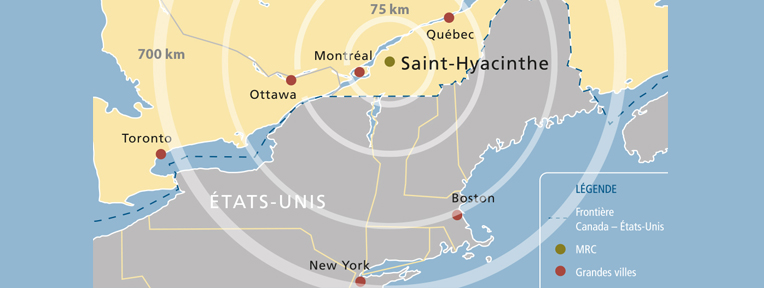FERTILE GROUNDS FOR BUSINESS
Located in the province of Quebec, on the outskirts of the Greater Montréal Area, the city of Saint-Hyacinthe has over 52 000 inhabitants.
Saint-Hyacinthe is one of the county seats of Montérégie, Quebec’s second largest region. As such, it is a major administrative, governmental and legal centre, home to a number of public and private institutions. It is also served by a vast network of educational institutions (regular and higher education) and health care establishments. Thanks to its many residential areas, parks and gardens and its cultural and recreational infrastructures, Saint-Hyacinthe offers a very high quality of life.
National agri-food capital and world-renown agri-food technopole, the Saint-Hyacinthe area is a major economic centre for Quebec and Eastern Canada. Over the years, it has become a vibrant industrial and business hub, offering entrepreneurs and investors a highly stimulating and competitive economic environment.
With several industrial and commercial areas adapted to the needs of all types of goods and services businesses, Saint-Hyacinthe offers an exceptional welcome and a wide range of helpful services to businesses interested in setting up shop in the area (tax credit programs; logistical, financial and scientific support; professional services and more). Recent studies revealed that Saint-Hyacinthe has the most vibrant industrial sector in Quebec and is one of the 30 best business cities in Canada.
The region currently has over 400 manufacturing businesses, a quarter of which are in the agri-food and biotechnology sectors. It also has some 1 600 stores and businesses offering a variety of goods and services.

Strategic positioning
At the heart of the vast North American market
Recognized as one of Eastern Canada’s main industrial and economic areas, the Saint-Hyacinthe region is served by the country’s major highways and railways, providing direct, strategic access to a market of some 110 million consumers.
A world-reknown technopole
Due to its remarkable concentration of specialists in agri-food, veterinary and agri-environmental biotechnology, Saint-Hyacinthe became the first Canadian city to join the very prestigious International Association of Science Parks (IASP) in 1993, when it was accredited by the Association.
In addition to being Quebec’s main agricultural production centre, with some 1 200 crop and livestock farms, the region has also developed a prosperous food processing industry. Its territory has over 150 research, higher education and technology transfer institutions and industries specializing in agri-food. It employs over 8 000 people in this sector and has a pool of over 200 world-class researchers.
Saint-Hyacinthe also has some of Canada’s main agri-food companies on its territory (Agropur, Lassonde, Lallemand, Saputo), including two leading exporting companies, Olymel and Barry Callebaut.

A technology park dedicated to the bio-food industry
Drawing on its large number of high-level businesses and stakeholders, Saint-Hyacinthe Technopole inaugurated the City of Agri-Food, Veterinary and Agri-Environmental Biotechnology in 2003. Covering nearly 10 million square feet, the City is North America’s first technology park devoted exclusively to the bio-food sector. It already houses major players in this field and will enable numerous scientists to conduct their research. The major institutions surrounding the City and the tax advantages available make it an ideal location for developing agri-food, biotechnology and pharmaceutical businesses.
In 2011, the Association of University Research Parks (AURP) named the City of Agri-Food, Veterinary and Agri-Environmental Biotechnology the “World’s Best Emerging Research Park” during an award ceremony in New Orleans. That same year, it was the only technology park in Canada and one of only two in North America (along with a park in San Diego, U.S.A.) to be included in a prestigious study PricewaterhouseCoopers conducted for the European Commission on the performance of bioclusters. Of all the parks studied, the City was ranked at the same development level as parks in Paris, Oslo and Munich, coming in behind only Cambridge and San Diego.

A hotbed of knowledge
In the midst of all this momentum is the University of Montréal’s Faculty of Veterinary Medicine. The only veterinary school in North America where French is spoken, it is internationally recognized in animal husbandry, infectious swine diseases, equine medicine, and food quality and safety.
College-level professional programs also provide training in the agri-food biotechnology industry. The Saint-Hyacinthe College of General and Vocational Education (CEGEP) offers biotechnology and dietetics programs (food management consultancy) and the Saint-Hyacinthe Agri-Food Technology Institute (ITAQ) includes livestock production, agricultural equipment, food processing, horticultural and environmental production among its programs.
Product development infrastructures
The region offers agri-food businesses excellent technological guidance through its research and development support centres, which can help businesses develop their products and production processes.
- Saint-Hyacinthe Food Research and Development Centre (FRDC)
Specializing in food preservation, processing, quality and safety, the FRDC is the largest food processing research centre in Canada. It supports food and beverage processing businesses in their R&D efforts by giving them access to its human resources, infrastructures and documentary sources and through the transfer of technologies. - Cintech Agroalimentaire (agri-food)
Drawing on its multidisciplinary expertise, Cintech supports innovation and technology transfer in agri-food, from product design to marketing. It offers R&D laboratories, pilot plants and test kitchens.
A competitive business centre
Business region
Saint-Hyacinthe has one of the lowest business location costs in North America, as confirmed by a global KPMG study on business location costs for cities with up to 500 000 inhabitants. Saint-Hyacinthe came in second place in North America. The results were based on a business’ operation over a ten-year period.
Other studies revealed that Saint-Hyacinthe has the most vibrant industrial sector in Quebec and is one of the 30 best business cities in Canada.
Abundant resources
The Saint-Hyacinthe region is Quebec’s main agricultural production area, both for its number of agricultural businesses and the volume of products on the market. With its field crops and cattle, and dairy, hog and maple syrup production, Saint-Hyacinthe generates 20% of the province’s agricultural revenues.
It also gives food processing businesses access to clean potable water and an affordable sugar supply.

A stable, qualified labour force
Businesses in Saint-Hyacinthe can count on a large pool of specialized labour in several areas of activity. The agri-food sector alone has access to more than 500 students graduating from the region’s schools of higher learning each year, in the following programs:
- University of Montréal’s Faculty of Veterinary Medicine (veterinary medicine, livestock health and production, food safety)
- Saint-Hyacinthe Agri-Food Technology Institute (ITAQ) (food processing, livestock and horticultural production, agri-mechanical engineering, management and operations)
- Saint-Hyacinthe College of General and Vocational Education (CÉGEP) (biotechnology, livestock health, management)
- Saint-Hyacinthe Professional School (agri-food, horticultural and livestock production)

